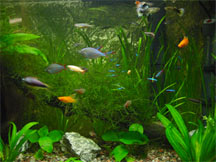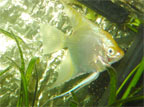
An established aquarium is one that the biological filtration has been matured. There are situations, however, that affect the nitrogen cycle in established aquariums, such as: adding livestock; unnoticed death in the aquarium; overfeeding; medicating the aquarium; and system maintenance.
Adding aquatic life
In the biological filter of an established aquarium, there are just enough bacteria to handle the biological load that is placed on the system at that time. When we add aquatic life to this system, we are increasing the amount of ammonia for the bacteria in the biological filter to metabolize. This situation brings us back to the cycling process
(Part 2), where the bacteria begin to multiply to make up for the extra biological load. How high the toxins will become in the system is going to depend both on the amount of aquatic life added to the aquarium at one time, and the size of the aquarium. If too much aquatic life is added at one time, it is possible for the ammonia and nitrites to reach dangerous levels, which may lead to losses. It is important to minimize these levels by stocking the aquarium slowly over time, giving the biological filtration time to catch up to the load.
 Situations may arise where it is advantageous to stock the aquarium at a faster rate than the biological filtration can handle. These situations include:
Situations may arise where it is advantageous to stock the aquarium at a faster rate than the biological filtration can handle. These situations include:
- Buying aquatic life through the mail: Because of the price of shipping, most aquarists will place large orders when purchasing their aquatic life through a mail order company. Although they may offset the shipping cost in doing this, they are also placing the new and existing aquatic life in jeopardy.
- Adding many aggressive fish at the same time: It is best to acclimate aggressive fish of the same species at the same time. Doing this will allow the fish to set their own territories prior to one individual taking over the entire aquarium.
- Transferring aquatic life to a hospital tank: The hospital tank is typically a small aquarium with minimal filtration. Levels of toxins must be monitored closely when any number of fish are added to this new system.
Unnoticed death in the aquarium
It is possible in many aquariums, such as freshwater planted and saltwater reef aquariums, to have an inhabitant perish in a place where it cannot be seen. When this happens, the organism begins to decay, which places a large load on the biological filtration. Again, the nitrogen cycle can be thrown out of balance depending on both the amount of death in the system, and the size of the aquarium. Having a large aquarium, in this case, is advantageous because the ammonia being produced by the organism will be diluted by the large volume of water.
Overfeeding
 When feeding the aquarium, it is important that the food that is added for the fish and invertebrates is consumed within a short period of time. After a few hours, any food that is left uneaten in the aquarium will begin to be broken down by the bacteria and fungi, resulting in ammonia added to the system. This ammonia in turn becomes part of the biological load and if the amount of decaying food is great enough, can cause an imbalance in the biological filtration, often resulting in murky, cloudy aquarium water. If the aquarium has been overfed, it is essential to siphon out any uneaten food and to perform a 25% water change.
When feeding the aquarium, it is important that the food that is added for the fish and invertebrates is consumed within a short period of time. After a few hours, any food that is left uneaten in the aquarium will begin to be broken down by the bacteria and fungi, resulting in ammonia added to the system. This ammonia in turn becomes part of the biological load and if the amount of decaying food is great enough, can cause an imbalance in the biological filtration, often resulting in murky, cloudy aquarium water. If the aquarium has been overfed, it is essential to siphon out any uneaten food and to perform a 25% water change.
Medicating the aquarium
Many medications affect the ability of the bacteria to function in the biological filtration. For instance, anti-bacterial medications act in the way the name describes, by killing many types of bacteria. Unfortunately, the biological filtration is bacteria-based, and will be affected by these medications. Other medications such as copper, antibiotics, and ich treatments will also affect the filtration in different degrees. It is important, when treating an aquarium, to closely monitor both the ammonia and nitrite levels and to perform water changes or chemical filtration when necessary.
System maintenance
Water changes and filter maintenance will both affect the biological filtration to some degree. When performing water changes, it is important that the replacement water is free of any toxic chemicals such as chlorine. These chemicals can kill bacteria within the system and any water that is to be used, should be treated either by reverse osmosis, or by one of the many available liquid dechlorinators. Filter maintenance, if not done properly, can have a large effect on the biological filtration. Again, the beneficial bacteria responsible for the nitrogen cycle, populate in the greatest numbers where the water flow and oxygen content of the water are the highest. This is typically within the filter. When performing maintenance on the filter, it is ideal to leave the biological media untouched in order to preserve the bacteria. If there is no biological media within the filter, it is wise to change only 1/2 of the mechanical media at a time. The remaining media that is to be reused should be rinsed in water taken from the aquarium in order to preserve the bacteria colony.
[
Part 1 |
Part 2 |
Part 3 |
Part 4 ] |





